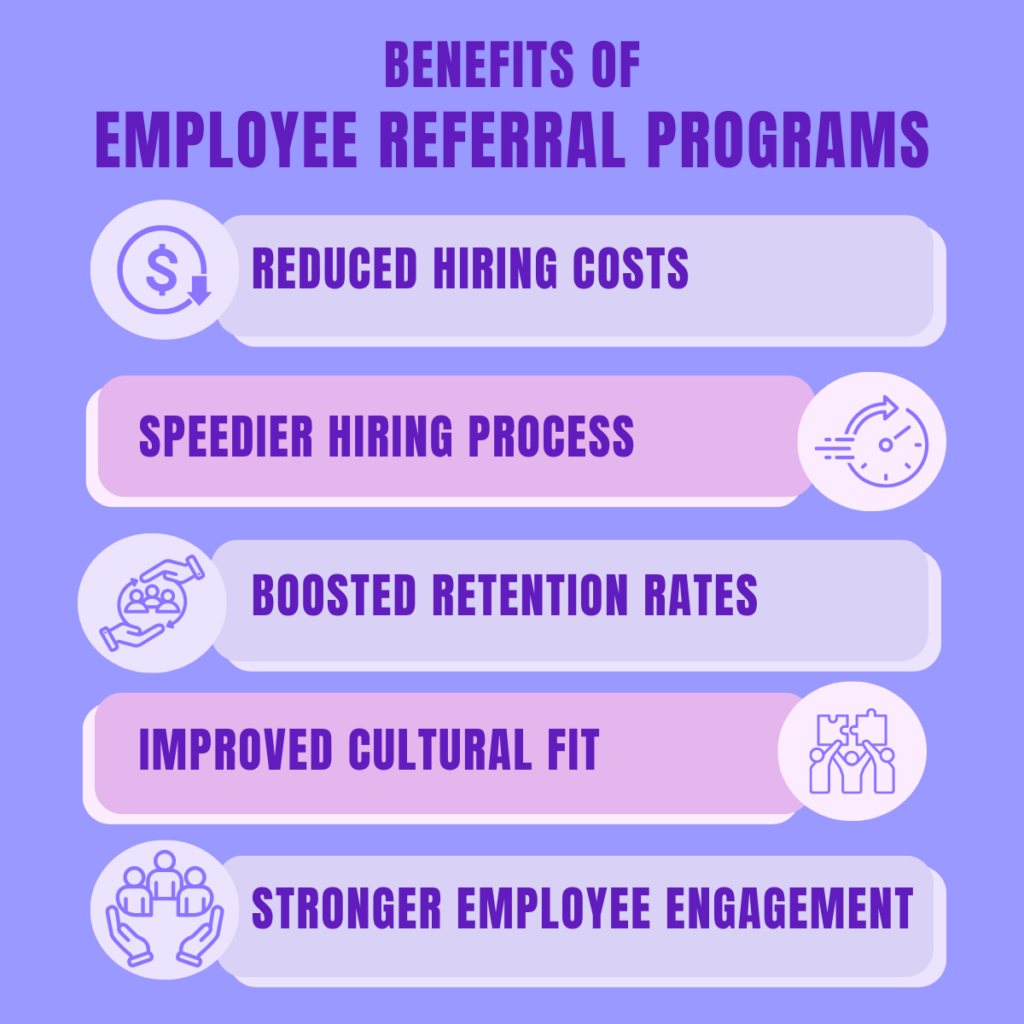
How to Measure the Success of Employee Referral Programs
In a tight labor market where competition for talent is fierce, employee referral programs (ERPs) stand out as one of the most powerful tools for attracting high-quality candidates. They’re fast, cost-effective, and incredibly efficient — and they can tap into the trusted networks of your existing employees to bring in top talent that comes with a built-in endorsement.
But while most companies know that referrals work, few have taken the time to build a referral program that’s strategic, structured, and measurable. In this guide, we’ll walk you through why employee referral programs matter, the benefits they bring, how to build one from scratch, and how to track its success.
Why Employee Referral Programs Matter
Employee referrals aren’t just a hiring shortcut. They’re a quality upgrade. Candidates who come in via employee referral programs tend to:
- Get hired faster
- Perform better
- Stay longer
- Fit more seamlessly into company culture
Employees are unlikely to risk their reputations by referring someone they don’t strongly believe in. That built-in screening means higher-quality applicants and fewer hiring headaches. Plus, when employees are encouraged to refer candidates, they feel more engaged, valued, and aligned with company goals.
Related: Beyond the Bonus: Motivate Employees to Refer Great Candidates
The Benefits of Employee Referral Programs
Employee referral programs offer a range of advantages that can significantly enhance your hiring strategy, workforce quality, and company culture.

One of the most immediate benefits is the reduction in hiring costs. By relying less on external recruiters, advertising, and job boards, organizations can save a considerable amount of money per hire. Referrals allow companies to source talent directly through their existing workforce, eliminating many of the traditional expenses associated with recruiting.
In addition to cost savings, referral programs dramatically speed up the hiring process. Candidates referred by current employees often come with a pre-established level of trust, which can help them move through the screening and interview stages more quickly. Hiring managers are more inclined to prioritize a resume that comes with an internal recommendation, which can shorten the time it takes to fill a role.
Retention rates also tend to improve when hires come through referral programs. Referred employees are more likely to stay with a company longer because they often have a clearer understanding of the company culture and job expectations, thanks to their connection with a current employee. They start with a built-in support system and someone to help them navigate their new role, which can lead to increased job satisfaction and loyalty.
Cultural fit is another crucial benefit. Employees are naturally inclined to refer people they believe will thrive in the company environment, which means referred candidates often align closely with the organization’s values and work ethic. This alignment can improve team cohesion and reduce the risk of hiring mismatches that lead to turnover.
Referral programs have a positive effect on employee engagement. When employees are given the opportunity to help shape their teams and contribute to the company’s growth, they feel more connected and invested in the organization’s success. Offering recognition and rewards for successful referrals reinforces this sense of ownership and can strengthen morale across the board.
In short, employee referral programs do more than just fill roles. They create a more efficient, engaged, and cohesive workplace that drives long-term success.
Related: How to Revive Your Employee Referral Program – Talroo
How to Build a Strong Employee Referral Program
Creating an effective ERP takes more than just offering a bonus. It’s about creating a process that’s easy to use, well-communicated, and motivating. Here’s how to get started:
1. Set Clear Goals
Start by defining what success looks like. Is your goal to reduce time-to-hire? Improve quality of hire? Increase diversity? Setting goals upfront will help you structure your program and measure its effectiveness later.
2. Map Out the Process
Design a simple and transparent referral process that answers key questions:
- How do employees submit referrals?
- What information must they include?
- What positions are eligible?
- What happens after a referral is made?
Make sure the process is documented and easy to follow. If it’s clunky or confusing, employees won’t bother.
3. Offer the Right Incentives
Cash rewards are common, but they’re not the only motivator. Consider tiered rewards, experiential perks, or recognition programs. What matters most is that the reward is:
- Meaningful to your employees
- Fairly distributed
- Paid out in a timely manner (ideally after the referral completes a set tenure)
Also, consider incentives for hard-to-fill or high-priority roles.
4. Make It Easy to Participate
Integrate the referral process into platforms employees already use, like Slack, your ATS, or your HR portal. Offer referral templates they can personalize and send. Remove as many barriers as possible.
5. Promote the Program Consistently
Don’t expect people to remember the program exists. Keep it top of mind with:
- Regular email reminders
- Spotlights on successful referrals
- Contests or campaigns around hard-to-fill roles
- Manager shout-outs during team meetings
The more visible and exciting the program is, the more likely employees are to engage.
6. Ensure Fairness and Transparency
Let employees know how candidates are progressing. A lack of feedback kills momentum. If an employee refers someone and never hears back, they’re less likely to do it again.
How to Measure the Success of Your Employee Referral Program
What gets measured gets managed — and can be improved. Use these key performance indicators (KPIs) to evaluate your ERP:
1. Referral Rate
What percentage of your total hires came from employee referrals? Benchmark this against industry standards and track changes over time.
2. Time-to-Hire
How quickly do referral candidates move through the hiring funnel compared to others? A shorter time-to-hire means your program is streamlining the recruitment process.
3. Retention Rate
What’s the retention rate of referred employees versus non-referred employees at 6, 12, and 24 months? Better retention is a sign of stronger culture alignment.
4. Quality of Hire
Look at post-hire performance metrics, promotion rates, and hiring manager satisfaction. High-performing referrals indicate your employees are choosing great candidates.
5. Participation Rate
How many employees are actively referring candidates? Low participation may suggest your program needs better visibility or more compelling incentives.
6. Diversity Metrics
Track how your referral program impacts the diversity of your workforce. While referrals are powerful, they can also lead to homogeneity if not managed thoughtfully. Encourage employees to think outside their immediate networks.
Final Thoughts: Start Anywhere and Keep it Going
Employee referral programs are more than just a hiring hack; they’re a culture strategy. When built thoughtfully and measured consistently, they become a pipeline of high-quality, loyal talent that drives long-term organizational growth.
To get there, focus on clarity, communication, and ongoing optimization. Empower your employees to be talent scouts, and reward them for helping shape the future of your workforce. With the right structure in place, your ERP can be one of the most effective recruiting tools in your HR toolbox.




